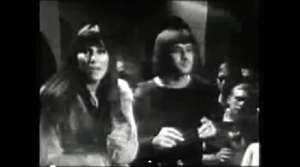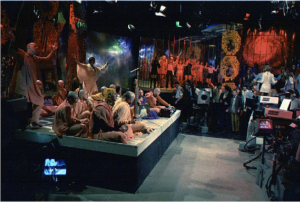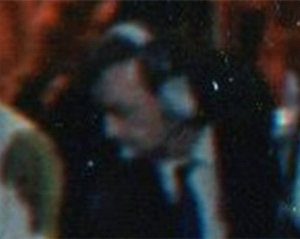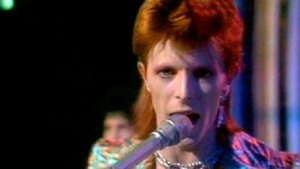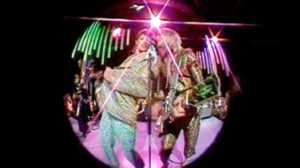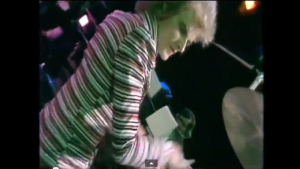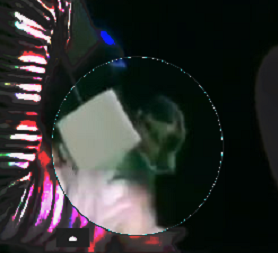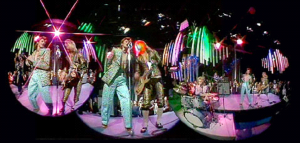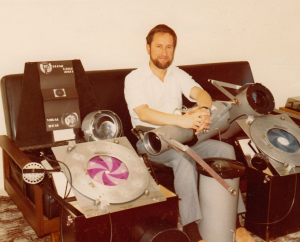Background
“Top of the Pops” began on New Year’s Day 1964 in Studio A on Dickenson Road in Rusholme, Manchester, Jimmy Savile and Alan Freeman presented the first show.
“Top of the Pops” was created by BBC producer Johnnie Stewart. The show was originally based on the Top 20. By 1970 the Top 30 was being used and the show was extended from 30 to 45 minutes duration.
Initially acts performing on the show mimed to the commercially released record, but in 1966 after discussions with the Musicians’ Union, miming was banned. After a few weeks during which some bands’ attempts to play as well as on their records were somewhat lacking, a compromise was reached whereby a specially recorded backing track was permitted – as long as all the musicians on the track were present in the studio. The TOTP Orchestra, led by Johnny Pearson augmented the tracks when necessary
[Wikipedia]
The first TOTP
The evening schedule for the day of the first ever TOTP:
16.45 – 17.10 The Pony
17.10 – 17.35 The Boss Cat (Top Cat)
17.35 – 18.00 Animal Magic
18.00 – 18.10 News
18.10 – 18.35 Town and Around
18.35 – 19.00 TOP OF THE POPS (Presented by Jimmy Savile)
19.00 – 19.35 Tonight
19.35 – 20.00 The Third Man
20.00 – 20.50 Z Cars
20.50 – 21.15 Sportsview
21.15 – 21.25 News
21.25 – 22.55 Festival: The Comedy of Errors
22.55 – 23.10 News Extra
23.10 – 23.15 Weather
Bill Jenkin
I think TOTP went to TC2 after Manchester. Then it went back to Manchester for a while and then to studio G Lime Grove Studios
Geoff Fletcher
The earliest mention of TOTP at TC in my diaries is Thursday 28 July 1965 if that’s any clue. It was in TC2 on Thursday 20 January 1966
Alec Bray
When TOTP moved from Manchester it went first to TC2. This was quite a small studio for this sort of production.
I worked on a number of TOTPs when we had the first appearance of a number of famous artists. One of the most notable was Sonny and Cher’s first appearance (12th August 1965) with their record “You got me Babe”. We did the stagger through with the artists in the planned position on the set, but after this there was an altercation between the artistes (Sonny and Cher) and the production staff. Eventually Johnny Stewart came down from the Gallery and spoke to Sonny and Cher – the “discussion” lasted some half-hour. The final words were Johnny Stewert’s: “ You are in England now, and in England the Director calls the shots,.” as he turned and went back up to the gallery.
Peter Neill
The move from TC2 to Studio G was occasioned by the move to live musicians and the need for space for the orchestra. It moved back to TC when it went colour.
John Henshall
The last time we (Crew 7) did Top of the Pops in TC2 was 23 June 1966. The next time we worked on it, 14 July 1966 – three weeks later – it was in G.
The move to G was good for me. I had designed a Fisheye attachment which had been rejected as a technical suggestion. Johnnie Stewart loved it. It bayonet fitted in place of the lens hood on 2-inch lenses but only worked on the EMI 203 cameras (in G) (due to their extended focus rack) and not Marconi Mk IVs (TC2) (until I later fitted an additional element).
Haven’t yet found my 1964 diary so I can’t check the Christmas edition but I THINK the 24 December 1964 edition was pre-recorded at Television Centre with Crew 7.
Alec Bray
After TOTP had moved to Lime Grove (where there was the TOTP orchestra – usually in the middle of the studio), we had the first appearance of Jimi Hendrix – who turned up over half an hour late for the session.
At another Jimi Hendix session. I was on a camera with a 12” lens on it (this was after Lime Grove had been updated to Image Orthicon cameras!) right in front of the drum kit (which was at the front of the rostrum). I had to crane up on the pedestal to take the shot, then quickly crane down so as to be out of shot of the other cameras – and I am sure I must have hit the cymbals on the way up and down!
Rex Palmer
TOTP was in Lime Grove Studio G for a year or two before eventually moving to TVC. One of my memories of those days was a lovely Irish production assistant (according to John Henshall, she was Ann(e) Doonican (Val’s niece)) counting down to the opening titles (they stopped at 3 which is another thing they got wrong in that Time and Space program!), everybody on the crew joined in when she got there, chorusing "Tree!".
John Wardle
TOTP was in LG G in 1969 when I became a studio engineer and moved to TC8 in colour about a year later with me following it. Cameras in TC8 were EMI 2001s and we had the dreaded Combined Video Apparatus Room shared with TC6 and 7.
In this picture, the cameras are EMI 2001 (which I probably did acceptance tests on) and Studio is almost certainly TC8.
David Brunt
The artists are the Radha Krishna Temple performing “Govinda” on the 19th March 1970 show. They were in studio twice, on 19th March and again on 9th April 1970.
Bernard Newnham
Maybe the man operating the camera with the John Henshall lens on the front is Peter Leverick.
Alec Bray
It was my last day at work for the BBC – before heading off for a “Vacation Job” and then off to college (and Uni).
“Top of the Pops” Lime Grove – and the last act – now number one in the charts – was the Tremolos with “Silence Is Golden” (probably on Thursday 25 May 1967: this was their second week at number one and it stayed at the top for a further week).
I was on a camera (camera 4) with a 12” lens on the turret. And the next to last shot was on me, an MCU on guitarist Rick West using the 12” lens. I had to pull well back for this shot and use the long focus lens, as the very last shot was on the Mole (by this time to my right) which had a wide shot of the group (and part of the dancing audience) and on the last rising note the Mole craned up to its full height. All fine and dandy.
Except the Mole spent most of the song on my LEFT side, crossing across to my right for this last shot.
On the (final) rehearsal everything went OK. On transmission everything was going well, and the Mole tracked across in front of me to get to its position. But the cable-bashers were not doing their job (for some reason) and as the Mole tracked back to get the wide shot, it pulled its camera cable tight round the front of my Ped. By this time I was on shot – on the long focus lens – and as the ped shuddered with the tightening cable, the shudder passed up the pan head and shuddered the lens. Of course, on a long focus lens the movement is magnified (however steady I tried to keep the camera. SO instead of finishing on a “high”, my last shot as a BBC Technical Operator (and Cameraman) was a decidedly shaky MCU on a 12” lens.
David Bowie – “The Jean Genie” TOTP
Background
David Bowie recorded "The Jean Genie" for Top of the Pops, the performance being broadcast on 4 January 1973. Unusually for the era, the four-piece band performed live, and included an extended guitar solo by Mick Ronson. Tapes of this edition of Top of the Pops were subsequently wiped, but a copy was made by BBC cameraman John Henshall, who had utilised the then new fisheye lens camera techniques for the performance.
John Henshall
The Fisheye lens used on the David Bowie "The Jean Genie" was my designed Telefex Fisheye 3 – much smaller and quicker to bayonet fit to the Angenieux ‘K’ lens than Keith’s fisheye(see below), which, along with his other effects, he sold to Telefex when he moved to Pebble Mill. (Telefex was my sister’s company).
I was the cameraman who shot "The Jean Genie" using the lens I designed on the EMI 2001 camera I was operating. I am even in shot in the background of one of the shots.
montage of fisheye shots …
Keith Salmon
…. had also designed a fisheye lens.
The fisheye lens designed and made by me can be seen on my knee in the picture below.
I had a company called VISUAL IDEAS which hired out optical effect to television; all my effects were designed and made by me.
My effects were used many times on TOTP, as I am sure TOTP crews will remember, and on other light entertainment shows. Rex Palmer was a great help to my wife when fitting effects on cameras during live TOTPs.
Dick Hibberd may remember them being used at Thames TV, and Mike Solomons at London Weekend.
When I moved from White City to Pebble Mill Birmingham in 1973 I sold all my optical effects to John Henshall.


